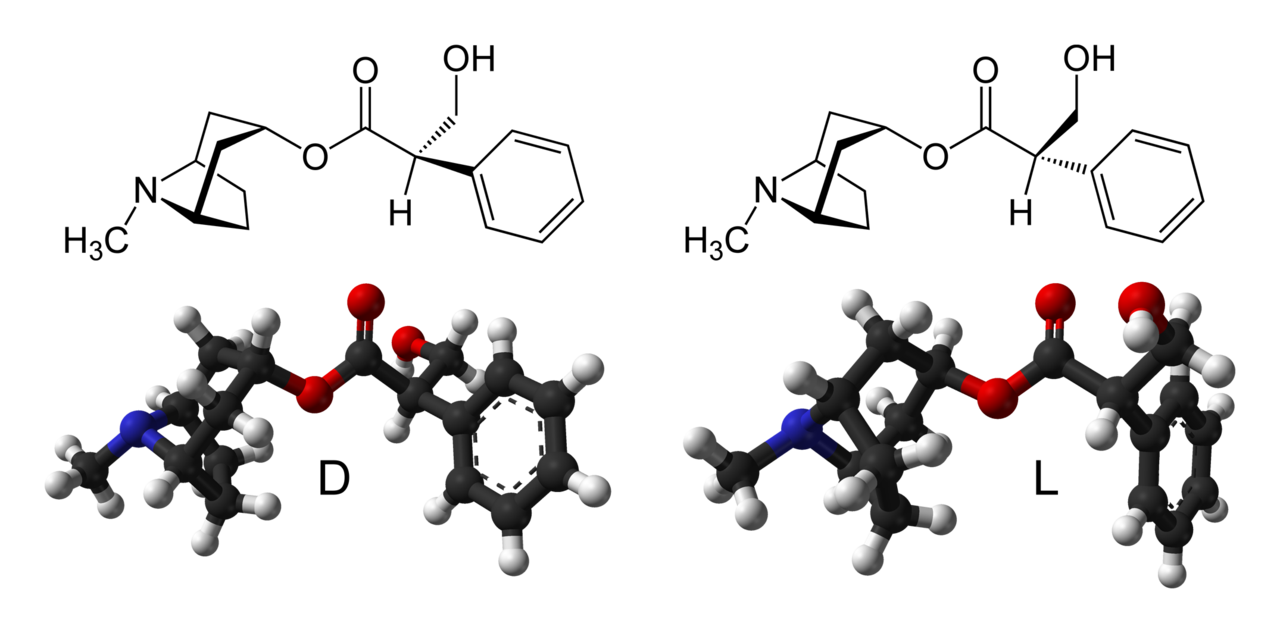Atropine (ophthalmic)
Editor-In-Chief: C. Michael Gibson, M.S., M.D. [1]; Associate Editor(s)-in-Chief: Adeel Jamil, M.D. [2]
Disclaimer
WikiDoc MAKES NO GUARANTEE OF VALIDITY. WikiDoc is not a professional health care provider, nor is it a suitable replacement for a licensed healthcare provider. WikiDoc is intended to be an educational tool, not a tool for any form of healthcare delivery. The educational content on WikiDoc drug pages is based upon the FDA package insert, National Library of Medicine content and practice guidelines / consensus statements. WikiDoc does not promote the administration of any medication or device that is not consistent with its labeling. Please read our full disclaimer here.
Overview
Atropine (ophthalmic) is an anticholinergic that is FDA approved for the treatment of cycloplegic refraction, for pupillary dilation desired in inflammatory conditions of the iris and uveal tract. Common adverse reactions include blurred vision, photophobia and local irritation.
Adult Indications and Dosage
FDA-Labeled Indications and Dosage (Adult)
- For mydriasis and/or cycloplegia. For cycloplegic refraction, for pupillary dilation desired in inflammatory conditions of the iris and uveal tract.
Dosing Information
- ATROPINE SULFATE SOLUTION: 1 or 2 drops in the eye(s) three times a day or as directed by a physician.
- FOR OPHTHALMIC USE ONLY.
Off-Label Use and Dosage (Adult)
Guideline-Supported Use
There is limited information regarding Off-Label Guideline-Supported Use of Atropine (ophthalmic) in adult patients.
Non–Guideline-Supported Use
There is limited information regarding Off-Label Non–Guideline-Supported Use of Atropine (ophthalmic) in adult patients.
Pediatric Indications and Dosage
FDA-Labeled Indications and Dosage (Pediatric)
There is limited information regarding Atropine (ophthalmic) FDA-Labeled Indications and Dosage (Pediatric) in the drug label.
Off-Label Use and Dosage (Pediatric)
Guideline-Supported Use
There is limited information regarding Off-Label Guideline-Supported Use of Atropine (ophthalmic) in pediatric patients.
Non–Guideline-Supported Use
There is limited information regarding Off-Label Non–Guideline-Supported Use of Atropine (ophthalmic) in pediatric patients.
Contraindications
- This product should not be used in patients with primary glaucoma or a predisposition to narrow anterior chamber angle glaucoma. This product should not be used in pediatric patients who have previously had a severe systemic reaction to atropine. This product should not be used in those persons showing hypersensitivity to any component of this preparation.
Warnings
- Not for injection into the eye. Do not touch dropper tip to any surface, as this may contaminate the solution. In pediatric patients, use with extreme caution. Excessive use in pediatric patients or in certain individuals with a previous history of susceptibility to belladonna alkaloids may produce systemic symptoms of atropine poisoning. If this occurs, discontinue medication, and use appropriate therapy as outlined in “OVERDOSAGE” section.
PRECAUTIONS
- To avoid excessive systemic absorption, the lacrimal sac should be compressed by digital pressure for two to three minutes after instillation. To avoid inducing angle closure glaucoma, an estimation of the depth of the angle of the anterior chamber should be made. Administration of atropine in infants requires great caution.
Patient Warning:
- Patients should be advised not to drive or engage in other hazardous activities while pupils are dilated. Patients may experience sensitivity to light and should protect eyes in bright illumination during dilation.
Parents should be warned not to get this preparation in their children’s mouth and to wash their own hands and the child’s hands following administration.
Adverse Reactions
Clinical Trials Experience
- Prolonged use may produce local irritation characterized by follicular conjunctivitis, vascular congestion, edema, exudate, and an eczematoid dermatitis. Severe reactions are manifested by hypotension with progressive respiratory depression. Coma and death have been reported in the very young.
Postmarketing Experience
There is limited information regarding Atropine (ophthalmic) Postmarketing Experience in the drug label.
Drug Interactions
There is limited information regarding Atropine (ophthalmic) Drug Interactions in the drug label.
Use in Specific Populations
Pregnancy
- Animal reproduction studies have not been performed with atropine. It is also not known whether atropine can cause fetal harm when administered to a pregnant woman or can affect reproduction capacity. Atropine should be given to pregnant women only if clearly needed.
Pregnancy Category (AUS):
There is no Australian Drug Evaluation Committee (ADEC) guidance on usage of Atropine (ophthalmic) in women who are pregnant.
Labor and Delivery
There is no FDA guidance on use of Atropine (ophthalmic) during labor and delivery.
Nursing Mothers
There is no FDA guidance on the use of Atropine (ophthalmic) in women who are nursing.
Pediatric Use
There is no FDA guidance on the use of Atropine (ophthalmic) in pediatric settings.
Geriatic Use
There is no FDA guidance on the use of Atropine (ophthalmic) in geriatric settings.
Gender
There is no FDA guidance on the use of Atropine (ophthalmic) with respect to specific gender populations.
Race
There is no FDA guidance on the use of Atropine (ophthalmic) with respect to specific racial populations.
Renal Impairment
There is no FDA guidance on the use of Atropine (ophthalmic) in patients with renal impairment.
Hepatic Impairment
There is no FDA guidance on the use of Atropine (ophthalmic) in patients with hepatic impairment.
Females of Reproductive Potential and Males
There is no FDA guidance on the use of Atropine (ophthalmic) in women of reproductive potentials and males.
Immunocompromised Patients
There is no FDA guidance one the use of Atropine (ophthalmic) in patients who are immunocompromised.
Administration and Monitoring
Administration
There is limited information regarding Atropine (ophthalmic) Administration in the drug label.
Monitoring
There is limited information regarding Atropine (ophthalmic) Monitoring in the drug label.
IV Compatibility
There is limited information regarding the compatibility of Atropine (ophthalmic) and IV administrations.
Overdosage
- Systemic atropine toxicity is manifested by flushing and dryness of the skin (a rash may be present in pediatric patients), blurred vision, a rapid and irregular pulse, fever, abdominal distension in infants, mental aberration (hallucinosis) and loss of neuromuscular coordination.
- Atropine poisoning, although distressing, is rarely fatal, even with large doses of atropine, and is self-limited if the cause is recognized and the atropine medication is discontinued. In severe intoxication, physostigmine salicylate may be administered parenterally to provide more prompt relief of the intoxication. Give physostigmine salicylate as 1-5 mL IV of dilution containing 1 mg in 5 mL of saline. The smaller dose is for pediatric patients, and injection should take not less than two minutes. EKG control is advisable. Dosage can be repeated every five minutes up to a total dose of 2 mg in pediatric patients and 6 mg in adults every 30 minutes. Physostigmine is contraindicated in hypotensive reactions. Atropine (1 mg) should be available for immediate injection if physostigmine causes bradycardia, convulsions or bronchoconstriction. In pediatric patients, the body surface must be kept moist.
- Use extreme caution when employing short-acting barbiturates to control excitement.
Pharmacology

| |

| |
Atropine (ophthalmic)
| |
| Systematic (IUPAC) name | |
| (RS)-(8-Methyl-8-azabicyclo[3.2.1]oct-3-yl) 3-hydroxy-2-phenylpropanoate | |
| Identifiers | |
| CAS number | |
| ATC code | A03 S01FA01 (WHO) |
| PubChem | |
| DrugBank | |
| Chemical data | |
| Formula | Template:OrganicBox atomTemplate:OrganicBox atomTemplate:OrganicBoxTemplate:OrganicBoxTemplate:OrganicBoxTemplate:OrganicBoxTemplate:OrganicBoxTemplate:OrganicBoxTemplate:OrganicBoxTemplate:OrganicBoxTemplate:OrganicBoxTemplate:OrganicBoxTemplate:OrganicBoxTemplate:OrganicBox atomTemplate:OrganicBoxTemplate:OrganicBox atomTemplate:OrganicBoxTemplate:OrganicBoxTemplate:OrganicBoxTemplate:OrganicBoxTemplate:OrganicBoxTemplate:OrganicBoxTemplate:OrganicBox |
| Mol. mass | 289.369 g/mol |
| SMILES | & |
| Pharmacokinetic data | |
| Bioavailability | 25% |
| Metabolism | 50% hydrolysed to tropine and tropic acid |
| Half life | 2 hours |
| Excretion | 50% excreted unchanged in urine |
| Therapeutic considerations | |
| Pregnancy cat. | |
| Legal status | |
| Routes | Oral, IV, IM, rectal |
Mechanism of Action
There is limited information regarding Atropine (ophthalmic) Mechanism of Action in the drug label.
Structure
- Atropine Sulfate Ophthalmic Solution USP, 1% is a sterile topical anticholinergic for ophthalmic use. The active ingredient is represented by the chemical structural formula:

Pharmacodynamics
- The anticholinergic effect of this product blocks the responses of the sphincter muscle of the iris and the accommodative muscle of the ciliary body to cholinergic stimulation, producing pupillary dilation (mydriasis) and paralysis of accommodation (cycloplegia).
Pharmacokinetics
There is limited information regarding Atropine (ophthalmic) Pharmacokinetics in the drug label.
Nonclinical Toxicology
There is limited information regarding Atropine (ophthalmic) Nonclinical Toxicology in the drug label.
Clinical Studies
There is limited information regarding Atropine (ophthalmic) Clinical Studies in the drug label.
How Supplied
Atropine Sulfate Ophthalmic Solution USP, 1% is supplied in a plastic squeeze bottle with a controlled tip applicator in the following sizes:
5 mL bottle – NDC 24208-750-60
15 mL bottle – NDC 24208-750-06
DO NOT USE IF IMPRINTED NECKBAND IS NOT INTACT
STORAGE:
Revised: January 2013
Bausch & Lomb Incorporated Tampa, FL 33637 ©Bausch & Lomb Incorporated
9114802 (Folded)
9114902 (Flat)
Storage
- Store between 15°-25°C (59°-77°F).
- KEEP OUT OF REACH OF CHILDREN.
Images
Drug Images
{{#ask: Page Name::Atropine (ophthalmic) |?Pill Name |?Drug Name |?Pill Ingred |?Pill Imprint |?Pill Dosage |?Pill Color |?Pill Shape |?Pill Size (mm) |?Pill Scoring |?NDC |?Drug Author |format=template |template=DrugPageImages |mainlabel=- |sort=Pill Name }}
Package and Label Display Panel
NDC 24208-750-06
BAUSCH + LOMB
Atropine Sulfate Ophthalmic Solution USP, 1% (Sterile)
Rx only

{{#ask: Label Page::Atropine (ophthalmic) |?Label Name |format=template |template=DrugLabelImages |mainlabel=- |sort=Label Page }}
Patient Counseling Information
- Patients should be advised not to drive or engage in other hazardous activities while pupils are dilated. Patients may experience sensitivity to light and should protect eyes in bright illumination during dilation.
- Parents should be warned not to get this preparation in their children’s mouth and to wash their own hands and the child’s hands following administration.
Precautions with Alcohol
Alcohol-Atropine (ophthalmic) interaction has not been established. Talk to your doctor about the effects of taking alcohol with this medication.
Brand Names
- Ocu-Tropine
Look-Alike Drug Names
There is limited information regarding Atropine (ophthalmic) Look-Alike Drug Names in the drug label.
Drug Shortage Status
Price
References
The contents of this FDA label are provided by the National Library of Medicine.